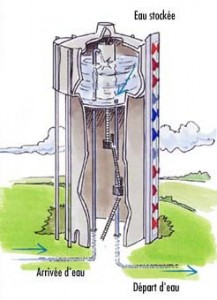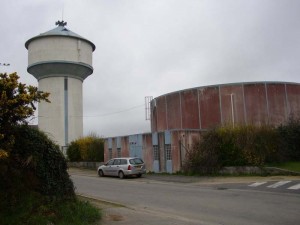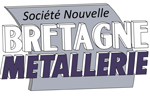The expression “Tower water” comes out in the French language in 1704. It indicates the works the family works of the castellum inherited from the Romans. The latter had reached a perfect control of the water conveyance thanks to their aqueducts. The water tower is part of the water tanks, it is a significant component of the distribution network. When landscape makes it possible to have an elevated topography to build a tank on the ground, it is this solution which is in general selected.
When the landscape is not appropriated, the builder of the network has the choice between a water tower (elevated tank) and a tank on the ground supplying a booster. In urban area the quantities of water required are such that the choice is generally made on a high pressure network.
The water tower is composed of two principal parts: the tank and its support called turn.
The water tower fulfills a double function, to constitute a surge tank between the production of water and the distribution with the consumers and to deliver water. The production of water must be done as regularly as possible whereas the delivery is subjected to the request as of users. At any time of the day and at the peak of the demand for water, it is necessary that each user profits from a correct flow.
As far as possible these tanks are placed on a high grounds above the delivery source of the taps being served. The water supply will be able to use the natural phenomenon of the communicating vases to feed the distribution network.
A water tower is before hand a raised tank, only the absence of a sufficiently high relief it is necessary to build it on a tower.
The filling of the tank is made by automatic feed pump in way to maintain a level constant in the tank.
The water tower, in activity or not, holds an important place in the landscape. It was often disparaged because it would cause a “visual pollution” but the experiment shows that it remains an economic solution, reliable, that it can be aesthetic and that it does many favours by offering a high point for the area.
Even if most of the time the majority of the people does not see it any more or do not want any more to see it, others thought of embellishing it or using it for other uses that for water. It is mainly used as geodetic point by the IGN and can be used as support with the antenna-relays (firemen, local radios, mobile telephony, etc), but also like support for monumental paintings.
Today, when the water tower arrives at the end of the lifetime, it is somewhat forsaken but some thought of giving him a new life. It can be reconverted either as public building, or as residences, restaurants, etc.
A careful extrapolation on the totality in the metropolitan territory indicates a number of 16,000 the water towers. One would be able to know more precisely the population of the whales from the World oceans than that of the water towers in France.
Source Internet












